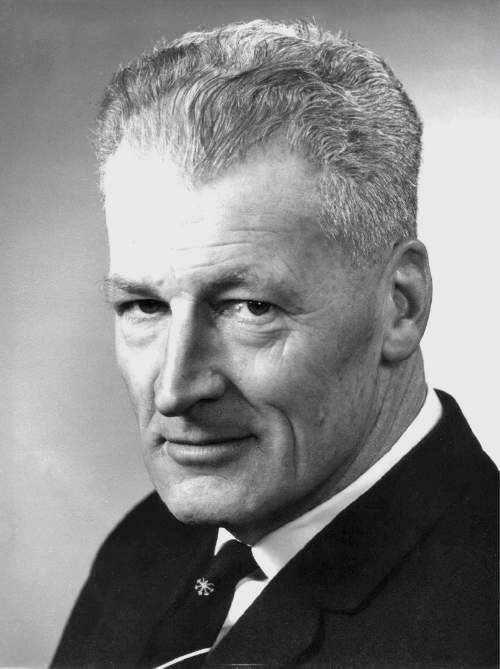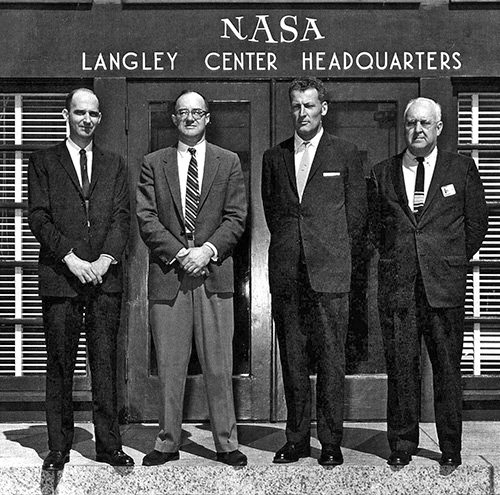26 November 1915 — 11 April 2003
Tom Lawrence
Thomas Fulton Coleman Lawrence AM 26 November 1915 — 11 April 2003 |
A tribute to Tom Lawrence by Des Barnsley.
Apparently delivered at the Memorial Service at University House, Australian National University, in April 2003.
_________________
Despite the sadness of Tom’s passing and the loss we all feel, we are fortunate and thankful in our individual ways for having known and been associated with such a remarkable person. In my own case, I am proud to have known him as a very good friend and professional colleague for more than fifty years.
Thomas Fulton Coleman Lawrence – known to many of his friends and colleagues as TFC – had a long, varied and successful career in defence science and engineering in the service of his country. He is a fine example of ‘local boy made good’, having been born in Yass on 26th November 1915 and spending a significant part of his life in the Canberra area.
I, and some of his colleagues here today, first met Tom in early 1948 at the Royal Aircraft Establishment in Farnborough, England. We were members of a small group of Australian scientists and engineers recruited to the then Long Range Weapons Establishment at Salisbury, South Australia and sent to England to ‘learn the ropes’ of rocket science and technology. We had been flown over in the luxury of flying boats at government expense while, on the other hand, Tom had travelled to England under his own steam, albeit assisted by that of a tramp steamer and was employed directly by the British Government as a Principal Scientific Officer in the Aero Department of the RAE.
That was the start of a long association with him for me and for many of his colleagues and it is now fitting to outline his professional career and, where appropriate, my association with it over these many years as generally they have been closely related.
Both of us were graduates of the University of Sydney, Tom in Civil Engineering and Science and myself, ten years later, in Aeronautical Engineering. Before World War II there was no aeronautical engineering degree course at Australian universities but Tom showed his interest in aeronautics by joining the Citizen Air Force, learning to fly and reaching the rank of Pilot Officer.
During the last ten years or so before retirement he was a Deputy Secretary in charge of all research and engineering in the Department of Supply and in a similar role in its subsequent aliases. At times he was Acting Secretary, this being an auspicious achievement because that was the largest Australian Government department at the time and known generally as the fourth arm of the Department of Defence.
There can be little doubt that Tom’s progression to such positions resulted from his varied and successful contributions to Australian defence science and technology, over the forty years of his professional career. In recognition of this service, he was awarded Membership of the Order of Australia (AM). He was also a Fellow of the Institution of Engineers (Australia) and a Fellow of the Royal Aeronautical Society. He actively supported the activities of these and other organisations also after his retirement in 1980.
His earlier experience included ten post-graduate years making significant contributions to the development of aeronautical expertise and facilities in Australia. He played a significant role in the design and construction of the first large wind tunnel – 9’ x 7’ working section – at the then CSIR Division of Aeronautics at Fishermens Bend in Melbourne. Tom was an early recruit, having joined this embryonic organisation in January 1940. It is a credit to him and his colleagues that this tunnel – albeit modified extensively – is still in operation over 60 years later.
He subsequently used these facilities in support of his work in the development of flight testing and performance evaluation techniques for military aircraft. At the end of World War II in 1945 he was a member of an Australian military mission to Japan to observe and report on that country’s aeronautical facilities.
Tom had also gained engineering experience outside government – first pre-war at the University of Melbourne and then, immediately post war, as Technical Superintendent with Australian National Airways – ANA – which ultimately became Ansett. He must have felt some sadness at Ansett’s demise, but certainly no responsibility!
The mid part of Tom’s career was spent at the Weapons Research Establishment at Salisbury, South Australia which he joined on return from the UK in the early fifties. Over the next ten years at Salisbury he was responsible for the management and the scientific and technical oversight of some advanced and novel concepts in rocket vehicle and weapons design, development and evaluation.
From 1958 to 1965, as Deputy Director Trials, he also played a significant role in the development of trials facilities and operational procedures at the Woomera range. During this period he was heavily involved in negotiations and cooperation with the UK in weapons development, with the US in support of Australian aspects of its space research activities including the Mercury, Gemini and high altitude research programs and with the European Launcher Development Organisation’s satellite development trials program in Australia.
At NASA’s Langley Research Center in Virginia, 3rd April 1959. Left to right: George B. Graves Jr (Langley), George E. Barlow (Department of Supply), Tom F.C. Lawrence (Weapons Research Establishment, Salisbury, South Australia) and Hartley A. Soule’ (Langley). From George Barlow via June Lawrence, scanned by Mike Dinn. |
His period as Chief Superintendent Aeronautical Research Laboratories in Melbourne from 1965 to 1968 presented him with many challenges in the development and supervision of its programs and ensuring that the scientific research being undertaken had appropriate relevance to the needs of the defence forces but, at the same time, not inhibiting more basic research endeavours.
In 1968 he was promoted to the position of Controller R & D and moved to Canberra. He was soon appointed to be the Deputy Secretary Research and Engineering and as said previously, remained in this or a similarly designated position until his retirement in 1980 on reaching his 65th birthday. Over this period he was involved in many departmental programs and responsibilities, including for a time, oversight of the activities of the Australian National Antarctic Research Expeditions and personally visited the Antarctic. On another memorable occasion he was Acting Secretary when Cyclone Tracy demolished Darwin on Christmas day 1974. He was instrumental in authorising and arranging some of the considerable logistic support needs such as the transport and stores capabilities of the Department of Supply.
Tom Lawrence has just presented a framed photo of Honeysuckle tracking Apollo 8 to NASA’s Dr George Mueller at Honeysuckle Creek on 01 December 1969. Left to Right: Allen Sharpe, Controller R&D, Department of Supply; Photo: Hamish Lindsay. 2024 negative scan by Colin Mackellar. |
Throughout his career Tom was a tireless worker and took a very detailed and personal interest in all matters in which he was involved – and there were many! He was very direct in his approach, always did his ‘homework’ and expected others to do the same. Woe betide those who failed to do so when discussing or debating any matter with him. This directness of approach and attention to detail sometimes may have caused impatience in some but Tom’s motives and intentions were never in doubt. He expected hard work, self discipline, accountability and loyalty but gave the same in return. His presence was apparent wherever he went and in whatever he did. In cricket parlance, he played off the front foot, rarely off the back and he let few balls go through to the keeper. He generally bowled economically and mostly just short of a length with an occasional well directed bouncer.
I was personally reminded of some of these characteristics during the design of the Long Tom high altitude research vehicle at WRE in 1957. Before clearing it for its first launch, he insisted on personally reviewing and being convinced by some of the detailed design calculations. Nevertheless we retained its name!
In this brief review of Tom’s career I wish to add a couple of personal experiences in which he assisted in the development of my own. In 1962 he nominated me to the Secretary of the Department of Supply to fill the position of R & D Attaché at the Australian Embassy in Washington DC which resulted in my selection for that posting. He was generous also in lending us a car for a week before our departure. On a later occasion he took a role in my move from Woomera to Central Office in Canberra in 1970.
June, Andrew, Ian, James and your families, I am honoured and privileged to assist in reviewing and celebrating Tom’s life and career. Barbara and I and all others here today join you in your loss.
In concluding I will recount an occasion which may cause all here today to reflect on their own experiences and association with Tom. Back in the 1970’s, he asked me to represent him at an interdepartmental meeting to consider a somewhat sensitive matter. At the end of my briefing with him I asked if there was any particular line I should take. With a slight smile and a twinkle in his eye he said “Act like you’re Tom Lawrence”!! That indeed would be a challenge to all of us.
_______
Special thanks to Barbara Barnsley for sharing this text and the photo. Image enhancement: Colin Mackellar.


